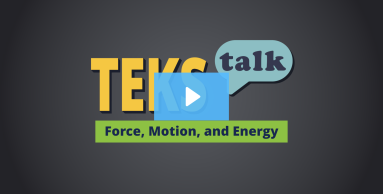- Science
- Grade 2
- Force, motion, and energy
Science.2.7.B
plan and conduct a descriptive investigation to demonstrate how the strength of a push and pull changes an object's motion.

Knowledge and Skills Statement
Explain to your students that you will provide each group of students with a cart, a string, and a stopwatch or timer. Ask students to develop a plan for how they might demonstrate how the strength of a push or pull changes an object's motion using those materials. Each group should write their plan down and get it approved by the teacher. Once each group has developed their plan, they should conduct their investigation and record their observations. Students may observe that a gentle push or pull makes the cart move forward slowly while a hard push or pull makes the cart move forward quickly.
The further explanation is designed to be a resource for educators that helps them better understand the topic their students are learning. Further explanations may be written at a more complex level than would be expected for students at the grade level.
The concept of different amounts of forces causing changes in motion is introduced through experiences with different strengths of forces. The concept of balanced and unbalanced forces will be added to this concept at grade 5 through "equal and unequal forces" and will be reinforced in grade 7. When two objects interact, each one exerts a force on the other. These forces can transfer energy between the objects. Forces between two objects at a distance are explained by force fields (gravitational, electric, or magnetic) between them. When the forces acting on an object are balanced (equal in all directions), the motion of the object does not change. When the forces acting on an object are unbalanced (unequal in one or more directions), the motion will change, for example, by changing speed or direction.
Thick Arrow: Icon made by RoundThick icons from www.flaticon.com
Thin Arrow: Icon made by Handicon from www.flaticon.com
Thick arrow URL: https://www.flaticon.com/free-icon/right-arrow_271226?term=arrow&page=1&position=5&origin=search&related_id=271226
Thin arrow URL: https://www.flaticon.com/free-icon/right-arrows_2989981?term=arrow&page=1&position=36&origin=search&related_id=2989981
Research
Wilcox, Jesse, Naryah Moore, Sarah Nolting, Courtney Reyna, and Caitlyn Potter. "Don't Force It!: Using Guiding Questions to Scaffold Kindergartner’s Thinking of Pushes And Pulls." Science and Children 59, no. 2 (2021): 33-37. https://www.jstor.org/stable/27133371.
Summary: This article explains the importance of questioning strategies and gives examples of how to do so when teaching the concept of push and pull. It states that teachers should avoid using "yes" or "no" questions instead of focusing on using age-appropriate open-ended questions. Physical examples are important when presenting a push-and-pull activity, specifically everyday examples, like children playing with sleds. Probing questions can help students predict what will happen and what will make an object move faster or slower. Teachers should have students predict what will happen if different variables are changed. Asking effective questions can help students generate ideas about force and motion.

